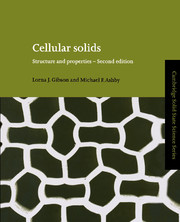Book contents
- Frontmatter
- Contents
- Preface to the second edition
- Preface to the first edition
- Units and conversion tables
- Chapter 1 Introduction
- Chapter 2 The structure of cellular solids
- Chapter 3 Material properties
- Chapter 4 The mechanics of honeycombs
- Chapter 5 The mechanics of foams: basic results
- Chapter 6 The mechanics of foams: refinements
- Chapter 7 Thermal, electrical and acoustic properties of foams
- Chapter 8 Energy absorption in cellular materials
- Chapter 9 The design of sandwich panels with foam cores
- Chapter 10 Wood
- Chapter 11 Cancellous bone
- Chapter 12 Cork
- Chapter 13 Sources, suppliers and property data
- Appendix: The linear-elasticity of anisotropic cellular solids
- Index
- References
Appendix: The linear-elasticity of anisotropic cellular solids
Published online by Cambridge University Press: 05 August 2014
- Frontmatter
- Contents
- Preface to the second edition
- Preface to the first edition
- Units and conversion tables
- Chapter 1 Introduction
- Chapter 2 The structure of cellular solids
- Chapter 3 Material properties
- Chapter 4 The mechanics of honeycombs
- Chapter 5 The mechanics of foams: basic results
- Chapter 6 The mechanics of foams: refinements
- Chapter 7 Thermal, electrical and acoustic properties of foams
- Chapter 8 Energy absorption in cellular materials
- Chapter 9 The design of sandwich panels with foam cores
- Chapter 10 Wood
- Chapter 11 Cancellous bone
- Chapter 12 Cork
- Chapter 13 Sources, suppliers and property data
- Appendix: The linear-elasticity of anisotropic cellular solids
- Index
- References
Summary
The formal description of elastic anisotropy
For some purposes the linear-elastic response of a foam can be thought of as roughly isotropic: its moduli are the same for all directions of loading. Then it is completely characterized by just two moduli (any two of Young's modulus, E*, the shear modulus, G*, the bulk modulus, K*, and Poisson's ratio, ν*, Chapter 5). But most man-made foams are anisotropic (Chapter 6): the Young's modulus in the rise direction is often twice as great as that in the other two perpendicular directions and the shear moduli and Poisson's ratios, too, depend on the direction of loading. Natural cellular solids are more anisotropic: the moduli of wood can differ by a factor of 10 along the grain and across it. And honeycombs are more anisotropic still, with moduli normal to the plane of the honeycomb which can be hundreds of times greater than those in-plane. As the symmetry of the material decreases, more moduli are required to describe the elastic response completely. It is helpful to know how many are needed, what they describe, and how they relate to each other.
- Type
- Chapter
- Information
- Cellular SolidsStructure and Properties, pp. 496 - 502Publisher: Cambridge University PressPrint publication year: 1997



